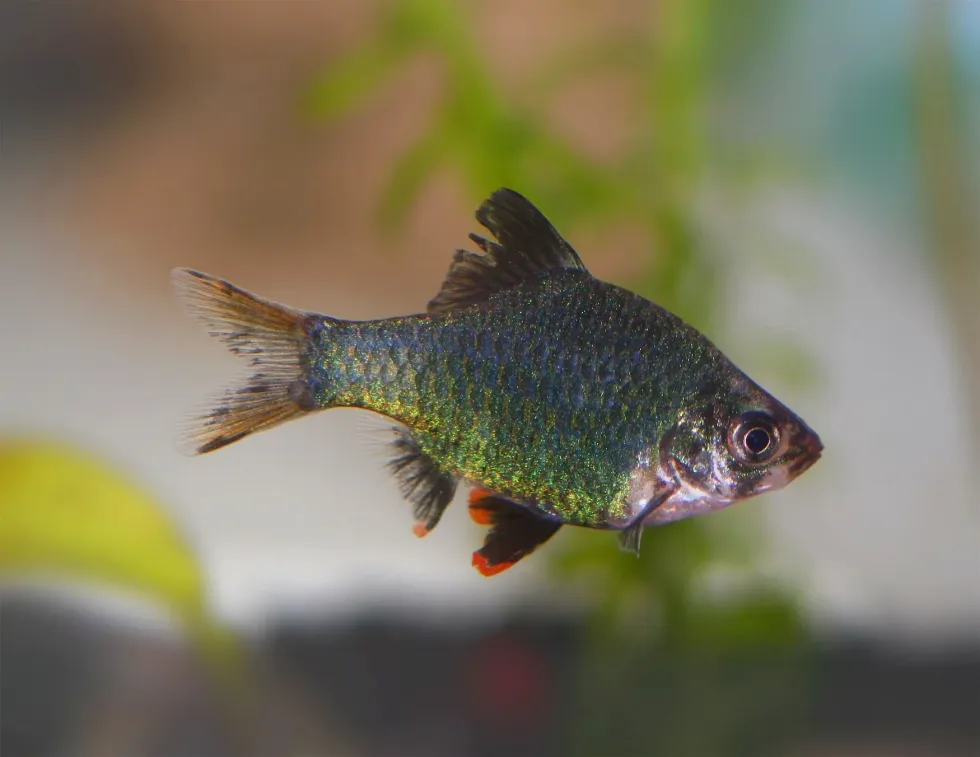The checkered barb (Oliotius oligolepis), formerly known as the checkered barb (Puntius oligolepis) is a member of the barb species group. These ray-finned fish are known for being beginner-friendly aquarium fish. The name Puntius oligolepis is etymologically derived from a Greek word that literally translates to 'less fish scale'.
Checkered barbs go by different names such as checkerboard barb, island barb, or just checker barb. Its appearance, specifically its black and silver markings, is the inspiration for its name, as it resembles a checkerboard.
These small fish are school fish who travel and live in groups in the wild. Being endemic to Sumatra, they are mostly found in wetlands of the west coast of Indonesia. They reproduce in large numbers and are also bred for commercial purposes.
If reading about this tropical fish interests you, why not read about the sawfish and mutton snapper too?
Checkered Barb Interesting Facts
What type of animal is a checkered barb?
The checkered barb from the family Cyprinidae is a tropical fish species.
What class of animal does a checkered barb belong to?
The checker barb belongs to the class Actinopterygii. The fish species in this class are also known as ray-finned fish and they are distinguished by their dermal bone fins. They are also referred to as Puntius oligolepis or Capoeta oligolepis.
How many checkered barbs are there in the world?
The checkered barb species was assessed in the year 2020. Records show its population trend to be stable and healthy. The estimated number of mature fish occurring in Sumatra is 10,000-100,000.
Where does a checkered barb live?
The checkered barb fish is endemic to Sumatra, Indonesia. Its habitat range is estimated to be 10,224 sq mi (26,479 sq km) in size, across the western coast. These areas include the Pinangsori Basin in the upper west coast and certain parts of the Kampar and Indragiri basins.
What is a checkered barb's habitat?
The checkered barb is usually found in the wetlands of Indonesia. Its population occurs both in permanent rivers, streams, and creeks that experience a faster-flowing current, and in freshwater lakes.
Being benthopelagic, it can survive at any level of the water body it inhabits. A famous choice as an ornamental fish, it can also be found in an aquarium.
Its preferred aquarium temperature would be in the range of 68 - 75 F (20 - 23.9 C). As a tropical fish, freshwater is best suited for its health, with the pH level set between 5.5-6.5.
Who do checkered barbs live with?
The checkered barb is a schooling fish, which means, they tend to live in groups. This can also translate well into your fish-keeping practices. Checkered barbs should be kept in at least groups of six to 10 individuals. They also bode well in a community aquarium because of their mild temperament.
How long does a checkered barb live?
Checkered barbs can live up to eight years. This is contingent on its care and aquarium conditions.
How do they reproduce?
As an egg-scattering spawner, it is relatively easy to breed this species. Little prior experience or expertise is therefore required.
Females of the species lay eggs whenever the spawning conditions are ideal. Experts recommend the use of a breeding tank to avoid conflicts between males and to gain control over the process.
Another thing to keep in mind is the predatory nature of the parents. Adults should be removed from the breeding tank containing the eggs and owners should ensure that there is enough vegetation in the aquarium to hold the eggs until they mature.
Spawning mops are an alternative, which can be bought or made at home as a DIY project. The eggs mature rather quickly and will hatch in 24-48 hours.
What is their conservation status?
According to the International Union for Conservation of Nature (IUCN) Red List, this fish species has been declared as Least Concern. Intensive research is required to map out its exact population trends and possible threats. At present, some of its range falls under nationally protected zones, which amounts to some protection.
Checkered Barb Fun Facts
What do checkered barbs look like?
The checkered barb is a small tropical fish that grows up to 2 in (5 cm) long. They are round in the middle and sharp at the edges and they have distinct black and silver checkered markings which became the source for their name.
Males tend to be smaller in size than females. To identify them, look at their dorsal fin.
A female's dorsal fin would be brownish-yellow whereas males have fins bearing a red tint. Two separate varieties are available when it comes to checkered barbs, one is green in color, whereas the other is on the red spectrum.

* Please note that this is an image of a tiger barb, not a checkered barb. If you have an image of a checkered barb, please let us know at hello@kidadl.com.
How cute are they?
As they are small and have interesting color patterns, they can be considered as cute fish like the neon tetra.
How do they communicate?
While specific information related to the communication of checkered barbs is not available. More generally, fish use sounds, colors, motion, and even smell, to communicate amongst each other. School fish specifically use synchronized movements to convey messages.
How big is a checkered barb?
The average checkered barb size is 2 in (5 cm). Compared to an average molly fish, it is two times smaller.
A male checker barb is usually smaller than a female checker barb and this species is quite small compared to other barb species. Its filament bar has a maximum size of around 7 in (18 cm), making it three times larger than checkered barbs. However, the checkered barb is almost the same size as a cherry barb.
How fast can a checkered barb swim?
The checkered barb prefers a moderate to high current speed in its natural habitat. Even in aquariums, they move at a high speed.
How much does a checkered barb weigh?
As the size of a checker barb is really small, its weight is insignificant.
What are the male and female names of the species?
Male and female checker barbs do not have separate names.
What would you call a baby checkered barb?
When the eggs hatch and the small fish are born, they are called fry.
What do they eat?
These island barb fish are omnivorous in nature and eat both plant-based food and other creatures. In their natural habitat, they feed on zooplankton, insects, shrimp, plants, and other crustaceans.
You may feed your pet barb fish frozen foods, brine shrimp, dried food, and pellets. You should do so at least twice a day.
Its comfort at different water levels is varied, but it tends to prefer to eat at the bottom. Decaying plant material in the substrate also adds to its diet. A healthy, varied diet will bring out their coloring well.
Are they poisonous?
No, checkerboard barbs are not known to be poisonous in nature.
Would they make a good pet?
Absolutely! The checker barb is a famous choice amongst the fish-keeping community. They have become a great ornamental fish option. It is relatively easy to manage its aquarium and perform other care duties for the fish. Caution must be applied while selecting tankmates though, as other fish should be tolerant to fast-paced fish like checkered barbs.
Did you know...
As school fish, a large population will inspire a healthy rivalry amongst males, enhancing their coloration.
Checkered barb tank mates
The checkerboard barb is a peaceful fish that cohabits well with other fish in an aquarium. They can be kept with other barb fish, rainbow fish, and danios. Preferably, the aquarium mates should be school fish by nature to allow a natural rhythm in your tank.
Checkered barb temperament
Most information about the checkered barb's behavior shows that not all barbs are aggressive. The Capoeta oligolepis is easy-going in nature but instances of aggressive behavior can be noted at times amongst males.
A healthy female-to-male ratio can help avoid this conflict. The checker barb will pick on weak males if there are not enough fish in your aquarium, so at least five barbs in a tank are required. Other peaceful barb species include the cherry barb, gold barb, and pentazone barb.
Here at Kidadl, we have carefully created lots of interesting family-friendly animal facts for everyone to discover! Learn more about some other fishes from our brown trout facts and Atlantic cod facts pages.
You can even occupy yourself at home by coloring in one of our free printable checkered barb coloring pages.
* Please note that this is an image of a green tiger barb, not a checkered barb. If you have an image of a checkered barb, please let us know at hello@kidadl.com.










